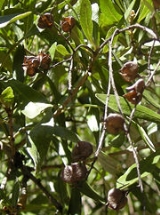
Bursaria
Encyclopedia
Bursaria is a genus
of large shrub
s and small tree
s which are native to Australia
. The genus was first described by Antonio Cavanilles
in 1797, with his description of the type species
B. spinosa
. The name is derived from the Latin
word bursa (purse
) which relates to the shape of its seed capsules.
Species include:
They occur in all Australian states and territories except the Northern Territory
.
There are also known to be protozoa
species of Bursaria.
Genus
In biology, a genus is a low-level taxonomic rank used in the biological classification of living and fossil organisms, which is an example of definition by genus and differentia...
of large shrub
Shrub
A shrub or bush is distinguished from a tree by its multiple stems and shorter height, usually under 5–6 m tall. A large number of plants may become either shrubs or trees, depending on the growing conditions they experience...
s and small tree
Tree
A tree is a perennial woody plant. It is most often defined as a woody plant that has many secondary branches supported clear of the ground on a single main stem or trunk with clear apical dominance. A minimum height specification at maturity is cited by some authors, varying from 3 m to...
s which are native to Australia
Australia
Australia , officially the Commonwealth of Australia, is a country in the Southern Hemisphere comprising the mainland of the Australian continent, the island of Tasmania, and numerous smaller islands in the Indian and Pacific Oceans. It is the world's sixth-largest country by total area...
. The genus was first described by Antonio Cavanilles
Antonio José Cavanilles
Antonio José Cavanilles was a leading Spanish taxonomic botanist of the 18th century. He named many plants, particularly from Oceania, his name is abbreviated as Cav...
in 1797, with his description of the type species
Type species
In biological nomenclature, a type species is both a concept and a practical system which is used in the classification and nomenclature of animals and plants. The value of a "type species" lies in the fact that it makes clear what is meant by a particular genus name. A type species is the species...
B. spinosa
Bursaria spinosa
Bursaria spinosa is a small tree or shrub in the family Pittosporaceae. The species occurs in mainly in the eastern and southern half of Australia and not in Western Australia and the Northern Territory. Reaching 10 m high, it bears fragrant white flowers at any time of year but particularly summer...
. The name is derived from the Latin
Latin
Latin is an Italic language originally spoken in Latium and Ancient Rome. It, along with most European languages, is a descendant of the ancient Proto-Indo-European language. Although it is considered a dead language, a number of scholars and members of the Christian clergy speak it fluently, and...
word bursa (purse
Purse
A purse is a small bag that may refer to:* Coin purse, in British English* Handbag, in American English* Money bag* WalletPurse may also refer to:...
) which relates to the shape of its seed capsules.
Species include:
- Bursaria calcicola L.Cayzer, Crisp & I.Telford
- Bursaria incana Lindl.
- Bursaria longisepala Domin
- Bursaria occidentalis E.M.Benn.
- Bursaria reevesii L.Cayzer, Crisp & I.Telford
- Bursaria spinosaBursaria spinosaBursaria spinosa is a small tree or shrub in the family Pittosporaceae. The species occurs in mainly in the eastern and southern half of Australia and not in Western Australia and the Northern Territory. Reaching 10 m high, it bears fragrant white flowers at any time of year but particularly summer...
Cav. (Sweet Bursaria or Blackthorn) - Bursaria tenuifolia F.M.Bailey
They occur in all Australian states and territories except the Northern Territory
Northern Territory
The Northern Territory is a federal territory of Australia, occupying much of the centre of the mainland continent, as well as the central northern regions...
.
There are also known to be protozoa
Protozoa
Protozoa are a diverse group of single-cells eukaryotic organisms, many of which are motile. Throughout history, protozoa have been defined as single-cell protists with animal-like behavior, e.g., movement...
species of Bursaria.
- Bursaria truncetella-cilliate

